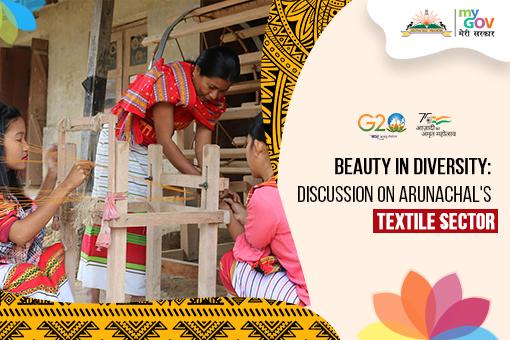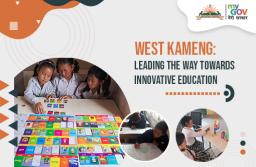Arunachal Pradesh traditionally known for its mesmerizing landscape is also home to a rich textile and handicraft industry. And because the state houses more than 20 major tribes and 100 sub-tribes, it is known for its diverse range of handloom and handicrafts, which are a reflection of the region's rich cultural heritage and traditional practices.
Handloom & Weaving: The handloom weaving industry is a significant source of employment in Arunachal Pradesh. The state is renowned for the excellent handmade textiles crafted by skilled weavers. The different tribes of Arunachal Pradesh weave using a variety of methods and designs to produce a wide range of textiles. Every tribe in the state has a distinctive weaving technique that is passed down from generation to generation. Each piece is distinctive and a testament to the weavers' abilities owing to the elaborate designs and patterns used in the weaving procedures.
The handloom weaving industry has enormous potential in Arunachal Pradesh, and many organizations and government bodies are working towards preserving and promoting this traditional craft. The state government has established a Handloom and Handicrafts Development Corporation to provide financial assistance, training, and marketing support to the weavers. The corporation also provides raw materials, looms, and other equipment to the weavers to create quality products.
Handicrafts: Arunachal Pradesh is also known for its diverse range of handicrafts, ranging from woodcarving to basketry. Each tribe in the state has its unique craftsmanship, creating beautiful products that showcase their traditional practices and cultural heritage. Some of the popular handicrafts of Arunachal Pradesh include bamboo and cane products, pottery, woodcarving, and beadwork. Pottery is another traditional craft that has been practiced in Arunachal Pradesh for generations. Woodcarving is a traditional craft that is practiced by many tribes in Arunachal Pradesh with beautiful patterns and beadwork is another popular craft in Arunachal Pradesh and is typically used to decorate clothes, bags, and jewelry.
Marketing and Export Opportunities:
Arunachal Pradesh's textile and handicraft industry has great potential to grow and expand. The state government has taken many initiatives to market and promote these crafts, particularly at the national and international levels, after realizing their full potential. The government has established several emporiums that sell these products and also participates in various trade fairs and exhibitions to showcase these crafts.
Furthermore, several NGOs and private organizations are working to create long-term employment opportunities for local artisans. These organizations train and empower artisans to produce high-quality goods while also assisting them in gaining access to markets.
MyGov Arunachal Pradesh invites citizens to share their valuable opinion and suggestions on how we can promote and market these local crafts to increase their reach and visibility.













BrahmDevYadav 2 years 5 months ago
Why is textile waste increasing?
Reduce, repair, donate. Textile waste is growing in large part due to increased sales of cheaper clothes and the trend of "fast fashion" that is leading to more garments being thrown out.
BrahmDevYadav 2 years 5 months ago
What is the full meaning of textile?
The fiber, filament or yarn used in making cloth.
BrahmDevYadav 2 years 5 months ago
What is the most important factor in textile sector?
Training and human resources are crucial for any labour-intensive industry and garment manufacturing is no exception. It is almost impossible to produce a quality product without a trained workforce.
BrahmDevYadav 2 years 5 months ago
What is efficiency in textile industry?
Efficiency is the ratio of total minutes produced and total minutes worked by an individual operator or a line. Efficiency is expressed in percentage. For example, stitching line efficiency of a typical stitching line is 56%.
BrahmDevYadav 2 years 5 months ago
What is the new technology in textile industry?
The availability of 3D technologies is driving the efficiency of textile manufacturing and design. 3D printing allows experiments with imaginative structures, shapes and prototypes. The technology also enables the production of different materials ranging from soft polymers to rigid ceramics.
BrahmDevYadav 2 years 5 months ago
What are the three ways of textiles?
Fabrics can be created in many different ways, the most common being weaving, knitting or through production of non-woven fabrics.
BrahmDevYadav 2 years 5 months ago
What are four sources of textiles?
Textiles are made from many materials with four main sources:-
1. Animal (wool, silk),
2. plant (cotton, flax, jute),
3. mineral (asbestos, glass fibre),
4. synthetic (nylon, polyester, acrylic).
The first three are natural. In the 20th century, they were supplemented by artificial fibres made from petroleum.
BrahmDevYadav 2 years 5 months ago
How can textile industry be eco-friendly?
To be sustainable, textile should be made from renewable materials. The eco friendly textile is made from fabrics produced in an environmentally friendly way without using chemicals and pesticides in the process of growing.
BrahmDevYadav 2 years 5 months ago
How can textile industry be eco-friendly?
To be sustainable, textile should be made from renewable materials. The eco friendly textile is made from fabrics produced in an environmentally friendly way without using chemicals and pesticides in the process of growing.
BrahmDevYadav 2 years 5 months ago
What are the problems faced by textile industry in India?
Shortage of raw materials and Low productivity of labour:-
Low production and illnesses in the mills are caused by fluctuating prices and unpredictability in the availability of raw materials.